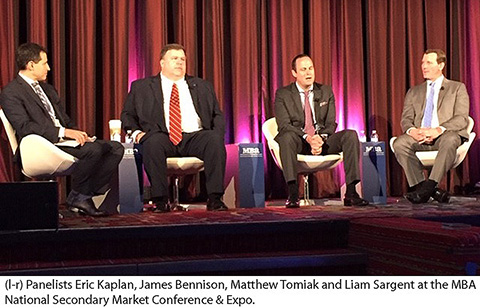
Bringing Private Capital Back to the Marketplace
NEW YORK–The secondary mortgage market, long-dominated in recent years by the government-sponsored enterprises, wants private capital to play a much larger role–the sooner, the better.
“We’ve been starting–and stopping–in getting the private-label secondary market going,” said MBA Chairman Chris George here at the Mortgage Bankers Association’s National Secondary Market Conference & Expo. “And while we’ve seen an uptick in private-label solutions, they continue to face issues.”
 “Private capital means a lot of things,” said Eric Kaplan, Director of the Housing Finance Program with the Milken Institute, New York. “Today, we’re seeing some pivotal movement in the market. Whether or not Congress does anything, everyone agrees–there should be more private capital in the market and we need it now, more than ever. But we need safety and soundness–no one wants to return to the days of 2008.”
“Private capital means a lot of things,” said Eric Kaplan, Director of the Housing Finance Program with the Milken Institute, New York. “Today, we’re seeing some pivotal movement in the market. Whether or not Congress does anything, everyone agrees–there should be more private capital in the market and we need it now, more than ever. But we need safety and soundness–no one wants to return to the days of 2008.”
“Post-crisis, there was a lot of learning,” said James Bennison, Executive Vice President of Alternative Markets with Arch Mortgage Insurance Co., Raleigh, N.C. “We’ve learned to ‘democratize’ the risk involved, so that we’re better positioned to manage risk in the marketplace.”
Historically, Bennison noted, the industry has assumed much of the risk. “Ultimately we understood that for [Arch] to get its private-label insurance program up and running, we took the long-term view. We were pleased to see that investor acceptance has been quite good and we now have the confidence of the ratings agencies.”
Bennison said there is “pent-up demand” for private-label securities. “Certainly, the advent of the credit-risk transfer programs by Fannie Mae and Freddie Mac [in 2013] set the stage for greater acceptance today,” he said.
Matthew Tomiak, Managing Director of Structured Finance with Redwood Trust Inc., Denver, agreed. “We were recently over-subscribed three times over for one of our private-label offerings,” he said. “There is demand, and it is smart demand.”
Tomiak said post-crisis, Redwood took a cautious approach, making small investments in 2009 and gradually building over the next several years.
“We should not be having a discussion over whether private capital is going to come back–private capital is back,” Tomiak said. “We’re here; we’re making purchases; we’re making investments. The market is not going to suddenly one day see a trillion-dollar investment. It’s coming back slowly, and it should come back slowly, over time, the way all markets do.”
Liam Sargent, Global Head of Asset-Backed and Non-Agency Mortgage Trading and Syndication with JPMorgan, New York, noted his bank has taken an active, aggressive role in the private-label market.
“We made a strategic decision back in 2011 to consolidate our risk into one place,” Sargent said. “It gives us so much information, which we can then bring back to the front to get the best price. It’s helped us isolate inefficiencies and use the technology we have to improve our balance sheet.”
Sargent noted there was considerable industry skepticism, as well as regulatory barriers. “Much of that skepticism involved compliance issues,” he said, “and TRID created a monster, making it difficult for us and others to adhere to 100 percent adherence.” He added JPMorgan hopes the market can get to the point where sampling would be an acceptable form of compliance. Meanwhile, he said, “it will always be easier to go through the GSEs instead of the private market.”
“Our world is very different today, post-crisis,” Bennison said. “We have a tremendous amount of work to do to create a viable private-label market outside the GSEs.”
“We’re in a constant evolution, “Tomiak said. “That’s a good thing. We’ve seen TRID; we’ve seen QM; we’ve seen non-QM. We’ve made adjustments as these features find their way into the system.”
